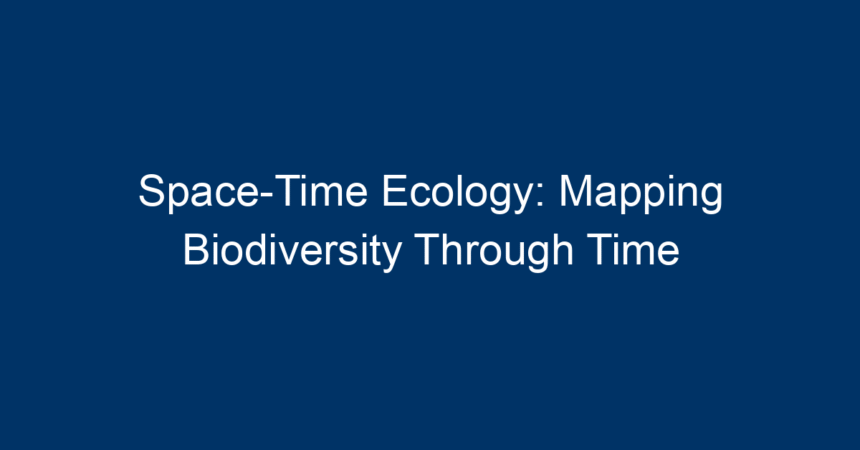Introduction
In an era where biodiversity is under unprecedented threat due to climate change, habitat loss, and pollution, understanding how species interact with their environments over time has never been more crucial. Space-time ecology emerges as a powerful framework that combines ecological data with spatial and temporal analyses. By mapping biodiversity through time, researchers can unveil the dynamic interplay between organisms and their habitats, leading to informed conservation strategies and sustainable practices.
Understanding Space-Time Ecology
The Concept of Space-Time Ecology
Space-time ecology is an interdisciplinary approach that integrates geography, ecology, and time to understand the distribution of biodiversity across scales. It emphasizes that ecosystems are not static; they evolve through interactions among species and their environments over time. By employing tools such as GIS (Geographic Information Systems) and remote sensing, ecologists can visualize and quantify changes in biodiversity.
The Importance of Temporal and Spatial Dimensions
In traditional ecological studies, researchers often analyze biodiversity at a single point in time or within a limited spatial scope. However, space-time ecology broadens the lens by considering how ecological processes unfold across different geographical locations and historical periods. This holistic approach can reveal patterns of species migration, adaptation, and extinction that might otherwise go unnoticed.
The Role of Technology in Space-Time Ecology
Geographic Information Systems (GIS)
GIS technology is pivotal in space-time ecology, allowing scientists to create detailed maps that depict spatial variations in biodiversity. These maps incorporate socio-economic data, climate models, and other relevant factors. By analyzing these rich datasets, researchers can pinpoint areas at risk and develop targeted conservation plans.
Remote Sensing
Remote sensing technologies, such as satellites and drones, provide real-time data on land use changes, vegetation cover, and species distribution. This data is invaluable for tracking biodiversity fluctuations over time. Remote sensing integrates seamlessly with GIS, enabling researchers to visualize the impact of climate change, urbanization, and other anthropogenic influences on ecosystems.
Mapping Biodiversity Through Time
Analyzing Historical Data
Historically, biodiversity data were collected through field studies and museum specimens. Modern space-time ecology leverages these historical datasets by overlaying them with current ecological data. This allows for an assessment of how species distributions have changed over decades or even centuries. By identifying trends, scientists can predict future changes and inform conservation efforts.
Case Studies in Space-Time Ecology
-
Species Migration Patterns: For example, the study of North American bird migrations using historical records and current GPS tracking data has unveiled shifts in migration routes due to climate change. These insights help conservationists identify critical habitats that need protection.
- Invasive Species Dynamics: In areas experiencing habitat disturbance, tracking the spatial and temporal spread of invasive species is essential. Space-time ecology tools help map these dynamics, enabling effective management strategies to curb their impact.
Implications for Conservation
Identifying Biodiversity Hotspots
Space-time ecology aids in pinpointing biodiversity hotspots—areas that are both rich in species and threatened by human activity. Understanding these regions’ temporal dynamics allows conservationists to prioritize efforts, ensuring that resources are allocated effectively.
Forecasting Future Trends
By employing predictive modeling based on past and present data, space-time ecology can forecast future biodiversity patterns. This capability is especially important in the context of climate change, where rapid environmental shifts require proactive management strategies.
Challenges in Space-Time Ecology
Data Limitations
Despite its potential, space-time ecology faces challenges, particularly regarding data availability and quality. Many regions lack comprehensive biodiversity datasets, hampering robust analyses. Efforts to standardize data collection and improve accessibility across different ecological studies are essential to overcome these hurdles.
Complexity of Ecological Interactions
The intricate relationships among various species and their environments add complexity to space-time ecological studies. Simplifying these interactions into models can sometimes overlook critical factors, leading to inaccuracies. Continuous refinement of models and collaboration across disciplines can help enhance our understanding of these dynamics.
Future Directions in Space-Time Ecology
Integration with Climate Models
The future of space-time ecology lies in its integration with climate models. By combining ecological data with climate projections, researchers can develop detailed assessments of how climate change will alter biodiversity patterns. This synergistic approach allows for more accurate forecasting and strategic planning in conservation efforts.
Citizen Science Initiatives
Engaging the public through citizen science initiatives can significantly enrich biodiversity data. By involving communities in data collection, researchers can expand their datasets while fostering public awareness of biodiversity issues. Educational programs can empower citizens to contribute to space-time ecology studies, creating a sense of ownership over local ecosystems.
Conclusion: Actionable Insights
Space-time ecology offers a transformative framework for understanding biodiversity dynamics. As we face an ecological crisis, leveraging this approach is vital in making informed conservation decisions. Effective mapping of biodiversity through time allows researchers and conservationists to:
-
Identify Critical Ecosystems: Focus on regions that require immediate action to protect biodiversity.
-
Implement Adaptive Management Strategies: Be responsive to current ecological shifts while planning for anticipated changes.
- Engage Communities: Foster public involvement in biodiversity preservation efforts through citizen science and educational outreach.
Incorporating the principles of space-time ecology not only enhances our knowledge of biodiversity but also equips us to navigate the turbulent waters of environmental change. By embracing this holistic approach, we can chart a sustainable course for the future of our planet’s ecosystems.




